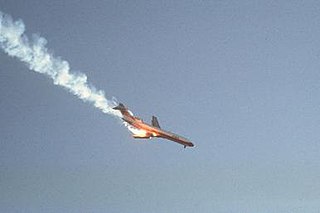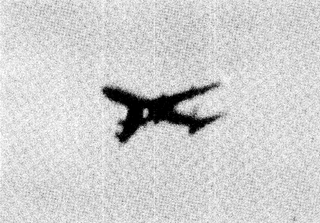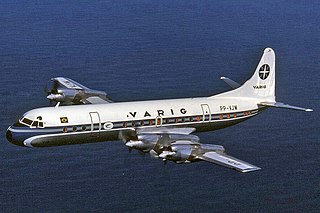
American Airlines Flight 587 was a regularly scheduled international passenger flight from John F. Kennedy International Airport to Las Américas International Airport in Santo Domingo, the capital of the Dominican Republic. On November 12, 2001, the Airbus A300B4-605R flying the route crashed into the neighborhood of Belle Harbor on the Rockaway Peninsula of Queens, New York City, shortly after takeoff. All 260 people aboard the plane were killed, as well as five people on the ground. It is the second-deadliest aviation accident in U.S. history, behind the crash of American Airlines Flight 191 in 1979, and the second-deadliest aviation incident involving an Airbus A300, after Iran Air Flight 655.

The Tenerife airport disaster occurred on March 27, 1977, when two Boeing 747 passenger jets collided on the runway at Los Rodeos Airport on the Spanish island of Tenerife. The collision occurred when KLM Flight 4805 initiated its takeoff run during dense fog while Pan Am Flight 1736 was still on the runway. The impact and resulting fire killed everyone on board KLM 4805 and most of the occupants of Pan Am 1736, with only 61 survivors in the front section of the aircraft, resulting in the worst aviation disaster in Spain. With 583 fatalities, the disaster is also the deadliest accident in aviation history.

An aviation accident is defined by the Convention on International Civil Aviation Annex 13 as an occurrence associated with the operation of an aircraft, which takes place from the time any person boards the aircraft with the intention of flight until all such persons have disembarked, and in which (a) a person is fatally or seriously injured, (b) the aircraft sustains significant damage or structural failure, or (c) the aircraft goes missing or becomes completely inaccessible. Annex 13 defines an aviation incident as an occurrence, other than an accident, associated with the operation of an aircraft that affects or could affect the safety of operation.

American Airlines Flight 191 was a regularly scheduled domestic passenger flight in the United States from O'Hare International Airport in Chicago, Illinois, to Los Angeles International Airport in California. On the afternoon of May 25, 1979, the McDonnell Douglas DC-10 operating this flight was taking off from runway 32R at O'Hare when its left engine detached from the wing, causing a loss of control, and the aircraft crashed less than one mile (1.6 km) from the end of the runway. All 258 passengers and 13 crew on board were killed, along with two people on the ground. With 273 fatalities, it is the deadliest aviation accident to have occurred in the United States.

Turkish Airlines Flight 981 (TK981/THY981) was a scheduled flight from Istanbul Yeşilköy Airport to London Heathrow Airport, with an intermediate stop at Orly Airport in Paris. On 3 March 1974, the McDonnell Douglas DC-10 operating the flight crashed into the Ermenonville Forest, outside Paris, killing all 346 people on board. The crash was also known as the Ermenonville air disaster. Flight 981 was the deadliest plane crash in aviation history until 27 March 1977, when 583 people perished in the collision of two Boeing 747s in Tenerife. It remained the deadliest single-aircraft accident until the crash of Japan Airlines Flight 123 on 12 August 1985, and the deadliest aviation accident without survivors until the Charkhi Dadri mid-air collision on 12 November 1996. It remains the deadliest single-aircraft accident without survivors, the first fatal hull loss and the deadliest crash involving the McDonnell Douglas DC-10, the sixth deadliest aviation disaster altogether, and the deadliest aviation accident to occur in France. It's also the deadliest aviation incident that did not involve a Boeing 747.

The Kegworth air disaster occurred when British Midland Airways Flight 092, a Boeing 737-400, crashed onto the motorway embankment between the M1 motorway and A453 road near Kegworth, Leicestershire, England, while attempting to make an emergency landing at East Midlands Airport on 8 January 1989.

Pacific Southwest Airlines Flight 182 was a scheduled flight of Pacific Southwest Airlines (PSA) from Sacramento to Los Angeles and San Diego. On September 25, 1978, the Boeing 727-214 serving the flight, registration N533PS, collided with a private Cessna 172 light aircraft, registration N7711G, over San Diego, California. It was Pacific Southwest Airlines' first fatal accident, and it remains the deadliest air disaster in California history. At the time, it was the deadliest air crash to occur in the United States, and remained so until American Airlines Flight 191 in May 1979.

Japan Air Lines Flight 123 was a scheduled domestic passenger flight from Tokyo to Osaka, Japan. On August 12, 1985, the Boeing 747 operating the service suffered a severe structural failure and decompression 12 minutes into the flight. After flying under minimal control for a further 32 minutes, the 747 crashed in the area of Mount Takamagahara, 100 kilometres from Tokyo.

The Lockheed L-188 Electra is an American turboprop airliner built by Lockheed. First flown in 1957, it was the first large turboprop airliner built in the United States. Initial sales were good, but after two fatal crashes that led to expensive modifications to fix a design defect, no more were ordered. With its unique high power-to-weight ratio, huge propellers and very short wings, large Fowler flaps which significantly increased effective wing area when extended, and four-engined design, the airplane had airfield performance capabilities unmatched by many jet transport aircraft even today—particularly on short runways and high field elevations. Jet airliners soon supplanted turboprops for many purposes, and many Electras were modified as freighters. Some Electras are still being used in various roles into the 21st century. The airframe was also used as the basis for the Lockheed P-3 Orion maritime patrol aircraft.

United Air Lines Flight 409 was a scheduled flight which originated in New York City, New York. The final flight destination was San Francisco, California, with stops in Chicago, Denver and Salt Lake City. The aircraft operating the service, a Douglas DC-4 propliner, registration N30062, crashed into Medicine Bow Peak, near Laramie, Wyoming, on October 6, 1955, killing all 66 people on board. The victims included five female members of the Mormon Tabernacle Choir and military personnel. At the time, this was the deadliest airline crash in the history of American commercial aviation. Another 66 lives had been lost earlier that year in the March 22 crash in Hawaii of a United States Navy Douglas R6D-1 Liftmaster military transport aircraft, and 66 had also died in the mid-air collision of two United States Air Force C-119G Flying Boxcars over West Germany on August 11, placing the three crashes in a three-way tie as the deadliest aviation incidents in 1955.

BOAC Flight 911 was a round-the-world flight operated by the British Overseas Airways Corporation (BOAC) that crashed near Mount Fuji in Japan on 5 March 1966, with the loss of all 113 passengers and 11 crew members. The Boeing 707 jetliner involved disintegrated mid-air shortly after departing from Tokyo, as a result of severe clear-air turbulence.

All Nippon Airways (ANA) Flight 60 was a Boeing 727-81 aircraft making a domestic commercial flight from Sapporo Chitose Airport to Tokyo Haneda International Airport. On February 4, 1966, all 133 people on board died when the plane mysteriously crashed into Tokyo Bay about 10.4 km from Haneda in clear weather conditions while on a night approach. The accident was the worst involving a single aircraft and was also the deadliest accident in Japan at that time until All Nippon Airways Flight 58 crashed 5 years later, killing 162.

On March 4, 1966, Canadian Pacific Air Lines Flight 402 (CP402) struck the approach lights and a seawall during a night landing attempt in poor visibility at Haneda Airport in Japan. Of the 62 passengers and 10 crew, only 8 passengers survived.

The Llandow air disaster was an aircraft accident in Wales in 1950. At that time it was the world's worst air disaster, with a total of 80 fatalities. The aircraft, an Avro Tudor V, had been privately hired to fly rugby union enthusiasts to and from an international game in Ireland. On the return flight the aircraft stalled and crashed on its approach to land.

Mount Takamagahara is a mountain in the Gunma Prefecture of Japan, near Ueno village. Its measurement is 1,978.6 metres tall. Takamagahara is the world of heaven in Japanese mythology.
The Japan Airlines Safety Promotion Center is a museum and educational center operated by Japan Airlines to promote airline safety. It is located on the second floor of the Daini Sogo Building on the grounds of Tokyo International Airport in Ota, Tokyo, Japan. The center estimates that its facility is within five minutes walking distance from the Tokyo Monorail Seibijō Station.
Buddhist studies, also known as Buddhology, is the academic study of Buddhism. The term Buddhology was coined in the early 20th century by the Unitarian minister Joseph Estlin Carpenter to mean the "study of Buddhahood, the nature of the Buddha, and doctrines of a Buddha", but the terms Buddhology and Buddhist studies are generally synonymous in the contemporary context. According to William M. Johnston, in some specific contexts, Buddhology may be viewed as a subset of Buddhist studies, with a focus on Buddhist hermeneutics, exegesis, ontology and Buddha's attributes. Scholars of Buddhist studies focus on the history, culture, archaeology, arts, philology, anthropology, sociology, theology, philosophy, practices, interreligious comparative studies and other subjects related to Buddhism.
In aeronautics, loss of control (LOC) is the unintended departure of an aircraft from controlled flight and is a significant factor in several aviation accidents worldwide. In 2015 it was the leading cause of general aviation accidents. Loss of control may be the result of mechanical failure, external disturbances, aircraft upset conditions, or inappropriate crew actions or responses.
Japanese Bankers in the City of London: Language, Culture and Identity in the Japanese Diaspora is a 2000 nonfiction book by Junko Sakai, published by Routledge. This book describes the lives and cultures of employees at Japanese companies working in their London offices, mostly within the City of London, and includes Japanese and British employees.















